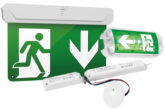
This article from the team at NVC Lighting gives an introduction to emergency lighting, its importance in the context of building safety and answers some key questions around its installation and maintenance.
Emergency lighting contributes to the safety of occupants during power outages or emergencies, providing illumination in critical areas, guiding occupants to exits safely and clearly.
It plays a critical role in the safety system of any building and as such, needs to be guaranteed to jump into action when required.
Proper installation and maintenance of emergency lighting systems are essential responsibilities, ensuring compliance with safety regulations and building codes. These systems are also a key aspect of risk management, protecting lives and property alike.
For electricians looking to learn more about emergency lighting, we’ll answer some key questions on its installation and ongoing maintenance.
This article should help build a core understanding of emergency lighting and mark a differentiation in the mind of the reader between aesthetic or practical lighting and emergency lighting.
QUESTION 1: How is emergency lighting powered?
Emergency lighting must be seen as a critical component of a safety system, not just a supplementary lighting feature. Its purpose is to provide illumination when the main power supply fails, ensuring safe evacuation in an emergency.
Unlike standard lighting that might be controlled by a switch live, emergency lighting requires a permanent live power supply. This ensures that the lights are activated automatically if the main electricity is cut off, and that they remain functional, even when the building’s other lighting systems are turned off. This continuous power source is vital to safeguarding occupants during critical situations.
QUESTION 2: What standards should emergency lighting adhere to?
The BS 5266 standard serves as a crucial code of practice for emergency lighting in the UK. While it is not a legal requirement on its own, adhering to this standard ensures compliance with all relevant legal obligations, including those within fire and safety regulations.
BS 5266 covers everything from system design and installation to maintenance and testing procedures, providing comprehensive guidelines for ensuring that emergency lighting is safe and effective.
Following this standard is essential to guarantee that the system performs as expected during emergencies, protecting both building occupants and employers from liability.
QUESTION 3: Whose responsibility is it to maintain emergency lighting?
Once the installation of an emergency lighting system is complete, it is crucial that a proper handover takes place to ensure the system is maintained correctly.
The building owner or manager typically takes responsibility for ongoing maintenance, but installers must provide thorough documentation.
There are two main types of testing systems: self-test and manual. Whichever method is used, proper upkeep is essential to ensure the lighting system remains functional in an emergency.
Wider context
An emergency lighting system’s role in the context of a building is all about functionality – there isn’t an aesthetic design consideration to be debated, and there isn’t a need for buildings to have the latest cutting-edge, pioneering technology. What’s paramount though is that the system does exactly what it’s installed to do when it is needed.
Aside from this, the wider adoption of the ‘Golden Thread’ in construction means that it is going to be more important than ever before that safety information relating to emergency lighting is closely monitored and recorded.
Records of these test results, as well as any updates, faults or fixes, need to be accurately recorded and traceable in order to contribute towards creating a full picture of a building’s safety critical system.
Self-test vs manual
Self-test systems automatically run checks and notify users of any faults, while manual systems require regular testing by personnel.
Testing and maintenance comes in the form of monthly ‘switch tests’ and an annual duration test. A switch test uses a momentary power interruption to show the lighting works under loss of power condition.
Duration tests are an annual requirement lasting three hours, where your primary light circuit must be switched off and your emergency lights left on for the full duration, with any defects to be reported and resolved as soon as possible.
On completion of a monthly or annual test, indicator LEDs and, where utilised, an audible buzzer will signal the status of the fitting.
This automated approach offers greater peace of mind, as well as reducing costs, but it is crucial that the information being received is utilised – and tracked – properly, so that any system failings are identified as quickly as possible and rectified.
Environmental considerations
LiFe PO4 (Lithium Iron Phosphate) batteries offer several advantages for emergency lighting systems.
They have a longer lifespan compared to traditional lead-acid batteries, often lasting up to eight years with proper maintenance and optimum conditions.
LiFe PO4 batteries are also more efficient, providing higher energy density in a lighter form, and they charge faster, offering a sustainable and cost-effective solution for emergency lighting systems.
Products
An effective emergency lighting set-up consists of several key components, each serving a specific function to ensure safety during a power failure:
Emergency luminaires
Light fixtures designed to operate during an emergency, either through maintained (always on) or non-maintained (only on during power loss) configurations.
Exit signs
Illuminated signage showing clear paths to exits, which remain lit during emergencies, guiding people safely out of the building.
Battery back-up systems
Essential for powering emergency lights when the main power supply fails. Modern systems often use long-lasting LiFe PO4 batteries.
Test systems
Either manual or self-testing, to regularly check that all emergency lighting is functioning as required.
Control units
Centralised panels that monitor the status of the emergency lighting system, allowing for system-wide checks and reporting on faults.
Each of these products works together to provide comprehensive emergency lighting coverage.
Browse NVC Lighting’s full emergency lighting range here
Find more industry technical articles here









